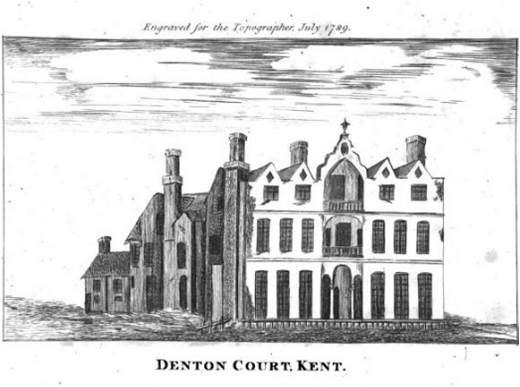MRP: Denton Court
Denton Court
Denton Court was the home of Sir Anthony Percivall, who died in 1646. A number of letters from and to Percivall have been published by D.K.Gardiner (1933 & 1937), drawn from Henry Oxinden of Barham's manuscripts at the British Library (MS. 28,000).
Building history
It seems likely that Denton Court was built a decade earlier than the mansion house of Deane, which was erected by Sir Henry Oxenden of Deane, ca. 1584. Henry Oxinden of Barham suggests in his commonplace book that the precise date was 1574, and cites John Tull senior, a surviving servant of his grandfather Sir Henry Oxenden of Deane (Add. MSS 54,332 , f. 22r). Tull's death is recorded against 1638 in Oxinden's same commonplace book.
Iune 26. 1638. Iohn ?Tull the Elder who was Tenent at Lodgelease, & formerly servant to my grandfather S:r Henry Oxinden dyed aged 75 yeares (Add. MSS 54,332 , f. 17r)
Lodge Lease farm house where John Tull the elder was tenant has survived and is a Grade II listed building. Listing details of Lodge Lease Farmhouse, ID 178581 describe it as;
House. C17 or earlier, clad early C19. Timber framed and clad with painted brick with plain tiled roof. Two storeys on plinth with hipped roof and triple clustered stack to centre left. Three mullioned and transomed wooden casements on first floor and 2 on ground floor with central French doors and sidelights and boarded door to centre left in gabled porch. Outshot with 1 wooden casement to right. Framed interior reported.
An article in The Topographer (1789) mentions the tradition that Denton Court was built by Richard Rogers, the last suffragan bishop of Dover, who died in 1597 (The Topographer, 1789: 236-237). However, the article also states that "in a late sale there of furniture, &c., there was found some old painted glass of the arms of the former owners, the Boys's, which, if it was not perceived there from the older house, looks as if they were the builders." (The Topographer, 1789: 237).
A description of the house follows, noting the "rather singular" style of architecture, "particularly the balconies." "The rooms within are large and lofty, and numerous. On the upper story, thro' the whole length of the front, runs a gallery, along the sides of which are small rooms and closets, and passages, enough to terrify a superstitious mind." The garden, which in 1789 was "now running wild," was "one of the last of those formal ones, called King William's, with high clipped hedges, terraces, and a mount, which was really introduced at least as early as the reign of King Henry VIII." The "materials of the house are brick, but the front has been cased over with plaister, probably in this century. The windows have also been sashed, which was originally, no doubt, the same as those which are now seen along the upper story, and at the side."
The situation of the house as described in 1789 was "very low." "On each side rises an abrupt and high hill. In the front is the village of Denton, and behind winds, for a mile or two, a most beautiful green valley, that affords the most pleasing sequestered walk imaginable."
The house was acquired by the barrister-at-law Samuel Egerton Brydges, Esq., in 1792. A topographical source from 1808 noted that "Denton Court had been for some time untenanted and was fast hastening to decay; but it has since been repaired and the grounds improved at the expense of several thousand pounds. It is built in the Elizabethan style, and contains a spacious and lofty Hall, Dining Parlour, Library, &c., together with a noble Gallery, which extends through the whole length at the front."
Images
'Denton Court, Kent,' in the The Topographer, vol. 1 (London, 1789, between p. 233 & 235
John Harris, The History of Kent. Denton Court, the Seat of Samuel Egerton Brydges, Esqr. (London, c. 1790), Copper engravings, 155 x 220mm
'Description of Denton Court, Kent,' in The Topographer, no. 4 (London, July 1789), pp. 235-239
Sources
Primary
Letter from Sir Anthony Percivall to Henry Oxinden (of Barham), 23rd June, 1643, MS. 28,000, f. 256
- Sir Anthony Percivall was Henry’s neighbour at Denton Court. Percivall was imprisoned with Sir Thomas Peyton at Mr. Offeld’s House in Billetter Lane, kept by the Sergeant-at-arms. Charged with misappropriation of public monies.
Letter (draft) from Henry Oxinden (of Barham) to Sir Anthony Percivall, Late June 1643?, MS.28,000, f. 406v.
- Commiseration on Percivall’s problems
Letter (draft) from Henry Oxinden (of Barham) to a Justice of the Peace, Probable date 1643, MS. 28,000, f. 400
- Seeking warrant to protect Percivall’s conies from poaching
Letter from Sir Anthony Percivall to Henry Oxinden (of Barham), 29th Sept. 1643, MS. 28,000, f. 269
Petition in Henry Oxinden’s handwriting to the House of Commons re. Sir Antony Percivall, No date [1643], MS. 28,000, f. 262
- Requesting Sir Antony Percivall be excused the fine of 6,000:li
Secondary
E.W. Brayley, The Beauties of England and Wales, Or, Delineations, Topographical, Historical, and Descriptive, of Each County: Kent, vol. 8 (London, 1808), p. 1077
